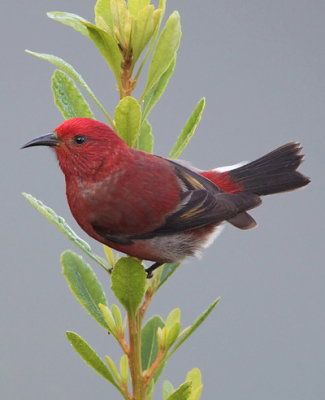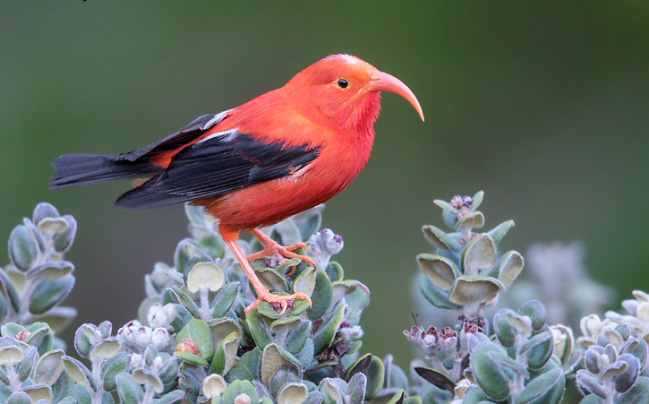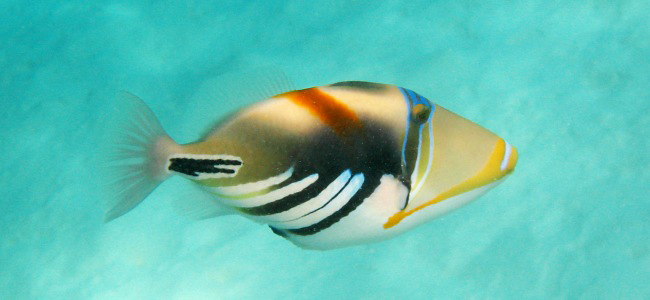

An Apapane in Koke'e State Park on the island of Kauai by Dubi Shapiro.
- Over 30 endemic landbirds, 26 on the main islands, including three elepaios (small monarch flycatchers), three solitaires (Olomao, Omao and Puaiohi), and 16 'honeycreepers' (now in the finch family) which occur only on the islands of Hawaii
- Spectacular seabirds such as Laysan Albatross, Red-tailed and White-tailed Tropicbirds, Great Frigatebird, Common White and Grey-backed Terns, Red-footed Booby, Hawaiian Petrel and Newell’s Shearwater
- And Bristle-thighed Curlew and the Hawaiian form of Black-necked Stilt
- As well as a chance to snorkel or scuba-dive with Spinner Dolphins, Manta Rays and Green Turtles, and numerous coral reef fish, in the rich, warm waters
- Also inhabited by Humpback Whales
- And the chance to see rivers of molten lava pouring out of one of the most consistently active volcanoes in the world, possibly spilling into the sea
- On spectacular volcanic islands battered by some of the biggest waves in the world

An Iiwi in Hosmer Grove, Haleakala National Park on the island of Maui by Dubi Shapiro.
- Since the arrival of Polynesians then Europeans and their introduction of many plants and animals, especially cats and rats, but also mosquitoes which spread avian malaria, together with other diseases, hunting and habitat degradation and destruction, there has been a mass extinction of native bird species on the islands of Hawaii and more birds have gone extinct here than anywhere else on the planet, a depressing situation compounded by the presence of more introduced birds than anywhere else in the world and very low numbers of many surviving native birds such as the critically endangered Akekee (about 310 individuals left in 2017), Akikiki (150), Maui Parrotbill (250) and Puaiohi (130), to which it may be necessary soon to add Palila the population of which could also be down to as few as 250 individuals. Not including fossils there were once at least 54 endemic bird species in the archipelago but by 2010 half were extinct and now only about 26, including 16 'honeycreepers', survive.
- Nearly two million seabirds nest on Midway Atoll NWR (over a million albatrosses (1.39 million in 2015, the highest ever count, up 52% since 2010) and about a million other seabirds) which lies in the Pacific between Hawaii and Japan, including, in addition to those species on the main islands of Hawaii, Black-footed Albatross, Masked Booby, Bonin Petrel and Christmas Shearwater. Amongst the numerous Laysan Albatrosses is the oldest known wild bird in the world, a female which was first ringed in 1956 when she was at least five years old and which at the age of at least 70 hatched yet another chick in 2021. A few Short-tailed Albatrosses are also usually present and in 2010-2011 a pair hatched a youngster there for the first time in recorded history. They raised a second in 2012 but just two sub-adults were present in 2015. About 14 million seabirds are believed to breed on the ten islands in the area (including Midway), in what is known as Papahanaumokuakea Marine National Monument. For information on how to visit Midway see the U.S. Fish & Wildlife Service website.
- Some reserves require special permission to visit. For example, to visit Waikamoi Preserve it is necessary to contact the Nature Conservancy and/or the Maui Forest Birds Recovery Project.
Best Birds and other wildlife in Hawaii
Birds
Endemics (Main islands) 26 Widespread 8 Hawaiian Goose (Nene), Hawaiian Duck (Koloa), Hawaiian Coot, Hawaiian Hawk (Io), Hawaiian Elepaio, Hawaiian Amakihi, Iiwi and Apapane.
(Ou is presumed extinct)
(Newell’s Shearwater is a breeding endemic (June to October) that ranges at sea, mainly east and south of the islands, and Hawaiian Petrel is a breeding endemic (April to October) that ranges widely at sea, mainly across the east Pacific)
Hawaii (Big) Island 5 Omao (Hawaiian Thrush), Palila, Akiapolaau, Hawaiian Creeper and Hawaiian Akepa.
Maui 4 Maui Alauahio (Creeper), Maui Nukupuu, Maui Parrotbill and Akohekohe (Crested Honeycreeper).
(Maui Akepa is presumed extinct)
Molokai 1 Olomao (Molokai Thrush).
Oahu 2 Oahu Elepaio and Oahu Amakihi.
(Oahu Alauahio is presumed extinct)
Kauai 6 Kauai Elepaio, Puaiohi (Small Kauai Thrush), Akikiki, Anianiau, Akekee and Kauai Amakihi.
(Kauai Nukupuu is presumed extinct)
Northwestern Islands 4 (It is not possible to visit these islands on standard tours) Laysan Duck (Laysan Island, and reintroduced to Kure and Midway Atolls), Millerbird (Nihoa, and reintroduced to Laysan), Laysan Finch (Laysan, and introduced to Pearl and Hermes Atolls) and Nihoa Finch (Nihoa only).
Specialities Laysan Albatross (mostly Nov-May), Grey-backed Tern and Bristle-thighed Curlew. Also a chance of Black-footed Albatross, Christmas Shearwater and Mottled Petrels.
Others Wedge-tailed and Sooty Shearwaters, Red-tailed and White-tailed Tropicbirds, Great Frigatebird, Brown and Red-footed Boobies, Black-crowned Night-heron, Common (Hawaiian) Gallinule, Black-necked (Hawaiian) Stilt, Pacific Golden Plover, Wandering Tattler, Sooty and Common White Terns, Black and Brown Noddies, and Short-eared Owl. Also a chance of Bulwer’s Petrel and other seabirds.
There are also many introduced species.
Mammals
Humpback (Nov-May, mostly Jan-Mar), False Killer and Short-finned Pilot Whales, (Indo-Pacific) Bottlenose,
(Long-snouted) Spinner and Spotted Dolphins, and Hawaiian Monk Seal. Also a chance of Sperm, Melon-headed, Pygmy Killer and Cuvier's Beaked Whales,
and Rough-toothed Dolphin.
Reptiles, Amphibians and Fish
It is possible to snorkel or scuba-dive with Manta Rays, (Pacific) Green Turtles (at known
cleaning stations) and Whitetip Reef Sharks, as well as numerous spectacular coral reef fish. About 450 species of coral reef fish occur around the
islands including the state fish which is one of two triggerfish known as Humuhumunukunukuapua’a, one of which is shown below. Also a chance of
Leatherback Turtle.

Picasso Triggerfish, or Humuhumunukunukuapua'a, by Marie-France Grenouillet.
Other Natural Wonders of Hawaii
Hawaii Volcanoes NP, Big Island Occasionally active lava flows spilling spectacularly into the sea, from Kilauea, one of the most consistently active volcanoes in the world, and a lava tube; a 120 m (400 ft) stretch of which is accessible to the public.
Haleakala, Maui A giant ‘crater’ about 800 m (2600 ft) deep, 3.2 km (2 miles) wide and 11 km (7 miles) long.
Mauna Kea ('White Mountain'), Big Island This mountain is 4205 m (13,796 ft) above sea-level but measured from its submarine base it is the 'highest mountain on Earth', 10,205 m (33,480 ft) above the bottom of the sea, 1357 m (4451 ft) higher than Everest at 8848 m (29,029 ft).
North Shore, Oahu Massive Pacific rollers, some of the largest waves in the world.
Waimea Canyon, Kauai Hawaii’s ‘Grand Canyon’, 20 km (12 miles) long and up to 800 m (2625 ft) deep.
Best Sites for Birds and other wildlife in Hawaii
- Big Island
- Saddle Road/Pu'u O'o Trail Akiapolaau, Hawaiian Elepaio, Omao and Iiwi, as well as Short-eared Owl.
- Mauna Kea/Pu'u La'au Trail Palila, Hawaiian Amakihi and Hawaiian Elepaio.
- Hakalau Forest NWR Hawaiian Hawk, Hawaiian Creeper, Hawaiian Akepa, Hawaiian Amakihi, Apapane, Akiapolaau, Hawaiian Elepaio, Omao and Iiwi.
- Hawaii Volcanoes NP Occasionally active lava flows and a lava tube. Also a chance of Black Noddy (colony at Holei Sea Arch), if, lava flows permitting, the Chain of Craters road is open all the way.
- Maui
- Haleakala NP Area A giant ‘crater’. Also a chance of Hawaiian Goose, Maui Alauahio and, at night, Hawaiian Petrel.
- Waikamoi Preserve Akohekohe, Maui Alauahio and Iiwi. Also a chance of Maui Parrotbill.
- Lahaina whale-watching boat trips leave from here.
- Oahu
- Kapiolani Park, Honolulu Common White Tern.
- Tantalus/Roundtop Loop near Honolulu Oahu Elepaio and Oahu Amakihi.
- Laie Point Wedge-tailed Shearwater. Also a chance of Christmas Shearwater and other seabirds.
- Manana Island and Makapu'u Distant Grey-backed and Sooty Terns.
- Kahuku Bristle-thighed Curlew, at the only regular wintering site on the main islands.
- James Campbell NWR and Kailua Area Black-necked Stilt. Also a chance of Bristle-thighed Curlew.
- Kauai
- Kilauea Point NWR Laysan Albatross, Red-tailed and White-tailed Tropicbirds, Great Frigatebird, Brown and Red-footed Boobies, Wedge-tailed Shearwater and Hawaiian Goose. Also a chance of Hawaiian Monk Seal.
- Hanalei NWR Hawaiian Goose, Hawaiian Duck and Black-necked Stilt.
- Waimea Canyon Road A spectacular canyon, Kauai Elepaio, Anianiau, Akekee, Kauai Amakihi, Iiwi, Apapane and White-tailed Tropicbird.
- Alakai WP Kauai Elepaio, Anianiau, Akekee and Kauai Amakihi. Also a chance of Puaiohi and Akikiki.
- Kauai boat trips Laysan Albatross, Red-tailed and White-tailed Tropicbirds, Great Frigatebird, Brown and Red-footed Boobies, Hawaiian Petrel, Newell’s and Wedge-tailed Shearwaters, Grey-backed and Sooty Terns, and Black Noddy. Also a chance of cetaceans and other seabirds.
- Lihue Seawatching, for Laysan Albatross, Great Frigatebird, Brown and Red-footed Boobies, Hawaiian Petrel, and Newell’s and Wedge-tailed Shearwaters. Also a chance of other seabirds.
- Wailua Bay Seawatching, for Hawaiian Petrel (late afternoon onwards).
- Makahu'ena Point Seawatching, for Newell's Shearwater.
Best Times for Birds and other wildlife in Hawaii
Humpback Whales are usually present from November to May, with their numbers peaking from January to March. Seabird diversity and numbers usually peak from late February to April with Newell’s Shearwaters usually returning by mid-April. April is also the time when many forest birds are at their most active and attractive.
Recommended Bird Books etc. for Hawaii
A Field Guide to The Birds of Hawaii and the Tropical Pacific by H D Pratt, P L Bruner and D G Berrett. PUP, 1987.
A Photographic Guide to the Birds of Hawaii by J Denny. University of Hawaii Press, 2010.
Birds of Hawaii, New Zealand, and the Central and West Pacific by B v Perlo. PUP, 2011.
Hawai'i's Birds and Their Habitats by H D Pratt and J Jeffrey. Mutual, 2013.
Ultimate Guide Hawaii Reef Fishes, Sea Turtles, Dolphins, Whales, and Seals by J P Hoover. Mutual, 2008.
Reef Fish Identification: Tropical Pacific by G Allen et al. New World, 2015 (Second Edition).
Birding and Wildlife Trip Reports for Hawaii
Many trip reports, some for Hawaii, are posted on the websites listed here. On some of these websites some reports are independent and some are posted by tour companies who organize tours to Hawaii. These tour companies and others also post their own reports on their websites, which are listed under 'Some Organized Tours to Hawaii' below.
- The best website for trip reports is CloudBirders
- but these are also worth a look
- Birdtours
- Fatbirder
- Jon Hornbuckle
- Mammal Watching
Local bird and wildlife guides in Hawaii
The costs of organized tours partly reflect the quality of the tour leaders. Some leaders are certainly better than others and many companies claim their leaders are the best but even the best rely at least to some extent on the exceptional skills of the local guides they employ. If you are travelling independently, employing such local guides will greatly increase your chances of seeing the wildlife you wish to see.
Accommodation for birders in Hawaii
Some Organized Tours for birds and other wildlife to Hawaii
There are many tour companies who organize tours to see mammals, birds, other wildlife and other natural wonders. The cost of these tours vary considerably according to such variables as the airlines used, the number of days the tours last, the number of sites visited, the number of people in the group (an important consideration if you wish to see such wildlife as rainforest mammals and birds), the number of tour leaders, the standard of accommodation and transport, and the percentage profit the company hopes to make. Generally, where the number of days tours last and the number of sites visited are similar, the cheapest tours are those that use the cheapest airlines, accommodation and local transport, that have the largest groups with the least number of leaders, and that make the least amount of profit. The most expensive tours tend to be those which are exceptionally long, use the most expensive accommodation (ridiculously lavish in some cases, even for single nights) and which make the most profit. Some tour costs partly reflect the quality of the tour leaders. Some leaders are certainly better than others and many companies claim their leaders are the best but even the best rely at least to some extent on the exceptional skills of the local guides they employ.
While tour companies organize tours with set itineraries many also organize custom tours for individuals and private groups who instead of taking a tour with a set itinerary want to follow their own itinerary to suit their own personal tastes, whether it be mammals, birds, other wildlife, other natural wonders or even man-made attractions, or a mixture of them all. Many organized tours with set itineraries are also fast-paced and target as many species as possible, whether they are mammals, birds or other wildlife or everything, which usually leaves little time to enjoy the best sites and individual species, but on a custom tour those taking part can specify the pace and the sites and species they wish to concentrate on. Custom tours also suit people who like to travel with people they already know, rather than with a group of strangers, and people with partners with different interests. Individuals and small groups will almost certainly have to pay more than the price of an organized tour with a set itinerary but a large group of friends may be able to travel for less than the price quoted for a set tour.
Tour companies who are running organized tours to Hawaii in the next couple of years include the following. Many of these also offer custom tours.
